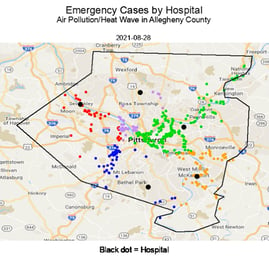Simulating Challenges from a Changing Climate
Problem
Climate change presents a serious challenge to cities that may face unanticipated stress on critical infrastructure and city services. In particular, climate science predicts a growing number of heat events that will threaten the health of vulnerable populations in urban settings. Major heat waves have caused thousands of excess deaths in the United States and Europe in the past decade. Regional planners across the globe are developing models to help them understand the impact of climate change on services including healthcare facilities, emergency response services and critical infrastructure.
Solution
 Under the "100 Resilient Cities" Program funded by the Rockefeller Foundation, Epistemix personnel worked with the City of Pittsburgh to develop and simulate a combined heat wave and air pollution disaster scenario. We used our platform to create a synthetic population that matched Allegheny County’s actual population statistics and demographics, including age, income, race, and household size. Then we assigned the risk of asthma to individuals in the population based on age, race and sex. We also took into account that the effects of air pollution vary by elevation in different areas of the City. Finally, we simulated and forecasted the effects of a heat wave and air pollution on the location, number, and timing of requests for emergency medical service, and measured the impact on specific hospital emergency departments within the City. Using ArcGIS, a user can ingest Epistemix output to visualize the results of models, create maps and movies, and perform spatial-temporal analysis.
Under the "100 Resilient Cities" Program funded by the Rockefeller Foundation, Epistemix personnel worked with the City of Pittsburgh to develop and simulate a combined heat wave and air pollution disaster scenario. We used our platform to create a synthetic population that matched Allegheny County’s actual population statistics and demographics, including age, income, race, and household size. Then we assigned the risk of asthma to individuals in the population based on age, race and sex. We also took into account that the effects of air pollution vary by elevation in different areas of the City. Finally, we simulated and forecasted the effects of a heat wave and air pollution on the location, number, and timing of requests for emergency medical service, and measured the impact on specific hospital emergency departments within the City. Using ArcGIS, a user can ingest Epistemix output to visualize the results of models, create maps and movies, and perform spatial-temporal analysis.
Results
Epistemix delivered model-derived insights to enable civic leaders to plan for the effects of climate change. The Epistemix approach brought together specific information about the demographics of a city's population, the spatial distribution of people with specific health risks, and the availability of healthcare centers to estimate the vulnerability of city's emergency medical response system to potential future heat and air pollution threats. Moreover, we can use the same analytical approach to forecast the effects of climate change -- or other anthropogenic or natural disasters -- for any county in the United States, providing tools for better resilience through preparedness planning.


